Business Structures: Sole Trader vs. Limited Company - Legal Analysis
VerifiedAdded on 2022/08/18
|6
|1967
|16
Report
AI Summary
This report provides a comprehensive analysis of business structures, specifically comparing the sole trader and limited liability company models. It begins by outlining the key features, advantages, and disadvantages of each structure, including the ease of setup, liability considerations, and capital limitations. The report then delves into the legal responsibilities associated with each structure, such as tax obligations, record-keeping requirements, and the implications of personal liability for sole traders. Furthermore, the report explores the legal responsibilities of company directors, including their duties as outlined in the Companies Act 2006. The report concludes by providing a comparative analysis to assist in making informed business decisions, considering the benefits and drawbacks of each structure, and offering guidance on compliance with relevant regulations.

Business lAW
Paraphrase This Document
Need a fresh take? Get an instant paraphrase of this document with our AI Paraphraser
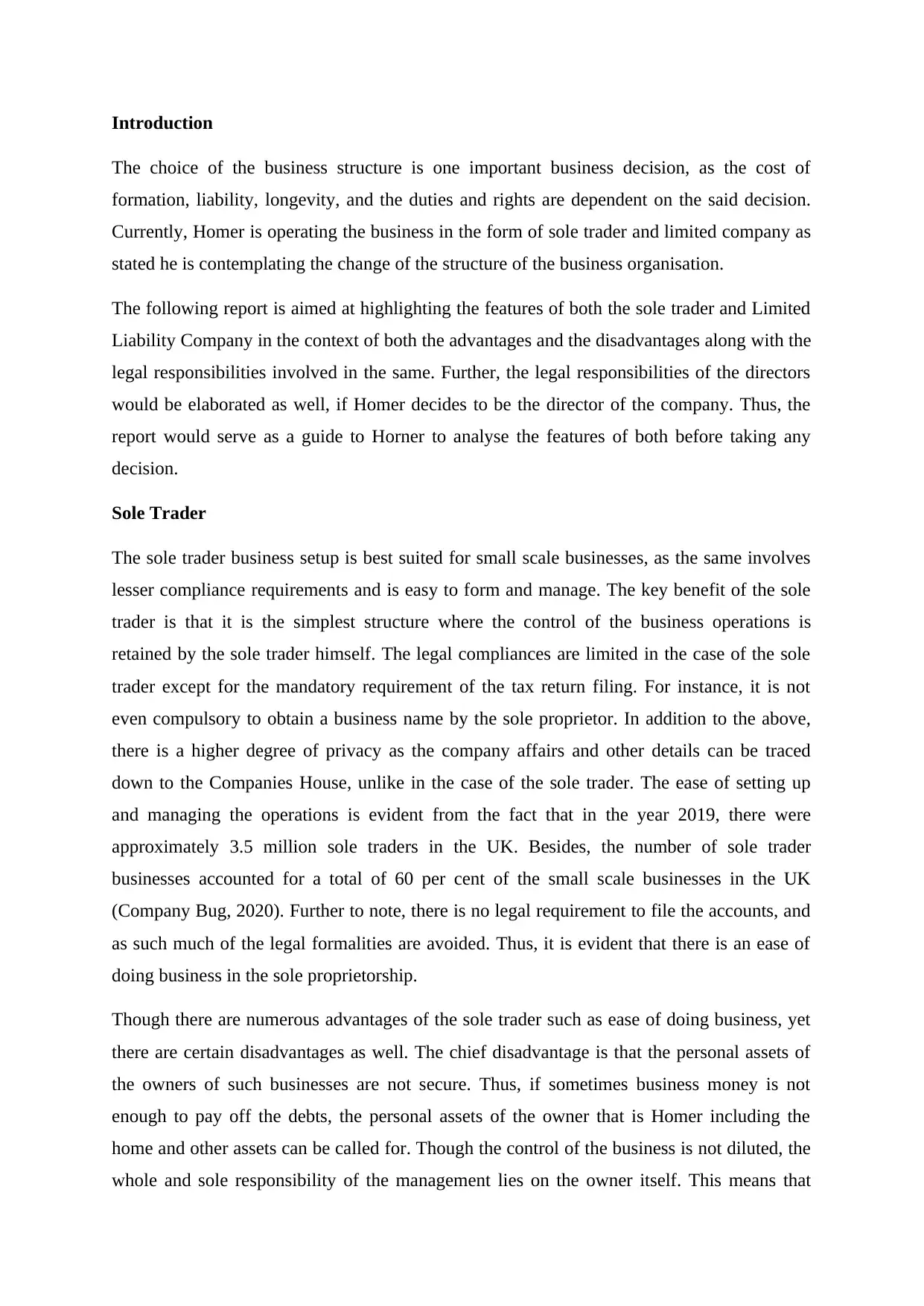
Introduction
The choice of the business structure is one important business decision, as the cost of
formation, liability, longevity, and the duties and rights are dependent on the said decision.
Currently, Homer is operating the business in the form of sole trader and limited company as
stated he is contemplating the change of the structure of the business organisation.
The following report is aimed at highlighting the features of both the sole trader and Limited
Liability Company in the context of both the advantages and the disadvantages along with the
legal responsibilities involved in the same. Further, the legal responsibilities of the directors
would be elaborated as well, if Homer decides to be the director of the company. Thus, the
report would serve as a guide to Horner to analyse the features of both before taking any
decision.
Sole Trader
The sole trader business setup is best suited for small scale businesses, as the same involves
lesser compliance requirements and is easy to form and manage. The key benefit of the sole
trader is that it is the simplest structure where the control of the business operations is
retained by the sole trader himself. The legal compliances are limited in the case of the sole
trader except for the mandatory requirement of the tax return filing. For instance, it is not
even compulsory to obtain a business name by the sole proprietor. In addition to the above,
there is a higher degree of privacy as the company affairs and other details can be traced
down to the Companies House, unlike in the case of the sole trader. The ease of setting up
and managing the operations is evident from the fact that in the year 2019, there were
approximately 3.5 million sole traders in the UK. Besides, the number of sole trader
businesses accounted for a total of 60 per cent of the small scale businesses in the UK
(Company Bug, 2020). Further to note, there is no legal requirement to file the accounts, and
as such much of the legal formalities are avoided. Thus, it is evident that there is an ease of
doing business in the sole proprietorship.
Though there are numerous advantages of the sole trader such as ease of doing business, yet
there are certain disadvantages as well. The chief disadvantage is that the personal assets of
the owners of such businesses are not secure. Thus, if sometimes business money is not
enough to pay off the debts, the personal assets of the owner that is Homer including the
home and other assets can be called for. Though the control of the business is not diluted, the
whole and sole responsibility of the management lies on the owner itself. This means that
The choice of the business structure is one important business decision, as the cost of
formation, liability, longevity, and the duties and rights are dependent on the said decision.
Currently, Homer is operating the business in the form of sole trader and limited company as
stated he is contemplating the change of the structure of the business organisation.
The following report is aimed at highlighting the features of both the sole trader and Limited
Liability Company in the context of both the advantages and the disadvantages along with the
legal responsibilities involved in the same. Further, the legal responsibilities of the directors
would be elaborated as well, if Homer decides to be the director of the company. Thus, the
report would serve as a guide to Horner to analyse the features of both before taking any
decision.
Sole Trader
The sole trader business setup is best suited for small scale businesses, as the same involves
lesser compliance requirements and is easy to form and manage. The key benefit of the sole
trader is that it is the simplest structure where the control of the business operations is
retained by the sole trader himself. The legal compliances are limited in the case of the sole
trader except for the mandatory requirement of the tax return filing. For instance, it is not
even compulsory to obtain a business name by the sole proprietor. In addition to the above,
there is a higher degree of privacy as the company affairs and other details can be traced
down to the Companies House, unlike in the case of the sole trader. The ease of setting up
and managing the operations is evident from the fact that in the year 2019, there were
approximately 3.5 million sole traders in the UK. Besides, the number of sole trader
businesses accounted for a total of 60 per cent of the small scale businesses in the UK
(Company Bug, 2020). Further to note, there is no legal requirement to file the accounts, and
as such much of the legal formalities are avoided. Thus, it is evident that there is an ease of
doing business in the sole proprietorship.
Though there are numerous advantages of the sole trader such as ease of doing business, yet
there are certain disadvantages as well. The chief disadvantage is that the personal assets of
the owners of such businesses are not secure. Thus, if sometimes business money is not
enough to pay off the debts, the personal assets of the owner that is Homer including the
home and other assets can be called for. Though the control of the business is not diluted, the
whole and sole responsibility of the management lies on the owner itself. This means that
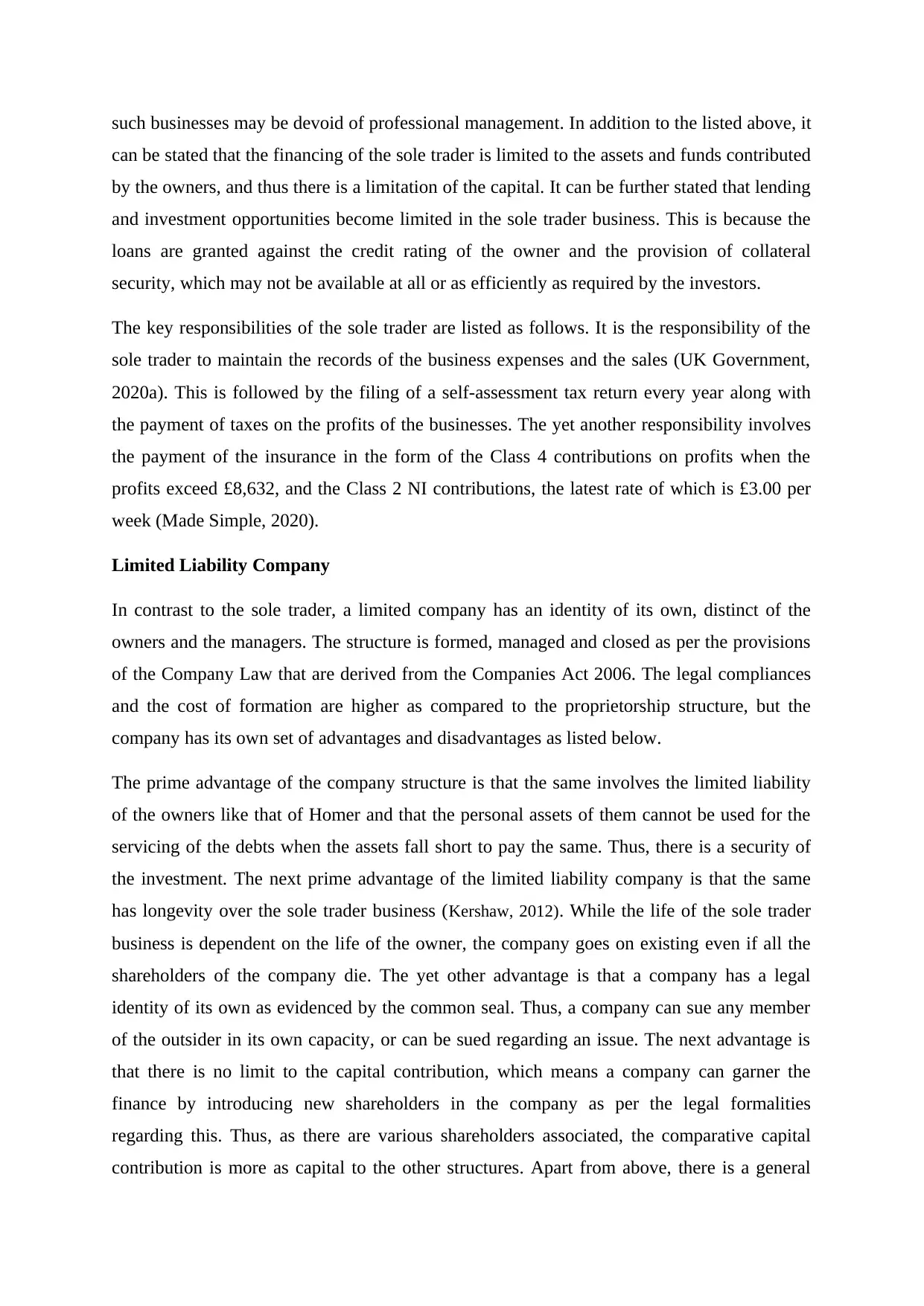
such businesses may be devoid of professional management. In addition to the listed above, it
can be stated that the financing of the sole trader is limited to the assets and funds contributed
by the owners, and thus there is a limitation of the capital. It can be further stated that lending
and investment opportunities become limited in the sole trader business. This is because the
loans are granted against the credit rating of the owner and the provision of collateral
security, which may not be available at all or as efficiently as required by the investors.
The key responsibilities of the sole trader are listed as follows. It is the responsibility of the
sole trader to maintain the records of the business expenses and the sales (UK Government,
2020a). This is followed by the filing of a self-assessment tax return every year along with
the payment of taxes on the profits of the businesses. The yet another responsibility involves
the payment of the insurance in the form of the Class 4 contributions on profits when the
profits exceed £8,632, and the Class 2 NI contributions, the latest rate of which is £3.00 per
week (Made Simple, 2020).
Limited Liability Company
In contrast to the sole trader, a limited company has an identity of its own, distinct of the
owners and the managers. The structure is formed, managed and closed as per the provisions
of the Company Law that are derived from the Companies Act 2006. The legal compliances
and the cost of formation are higher as compared to the proprietorship structure, but the
company has its own set of advantages and disadvantages as listed below.
The prime advantage of the company structure is that the same involves the limited liability
of the owners like that of Homer and that the personal assets of them cannot be used for the
servicing of the debts when the assets fall short to pay the same. Thus, there is a security of
the investment. The next prime advantage of the limited liability company is that the same
has longevity over the sole trader business (Kershaw, 2012). While the life of the sole trader
business is dependent on the life of the owner, the company goes on existing even if all the
shareholders of the company die. The yet other advantage is that a company has a legal
identity of its own as evidenced by the common seal. Thus, a company can sue any member
of the outsider in its own capacity, or can be sued regarding an issue. The next advantage is
that there is no limit to the capital contribution, which means a company can garner the
finance by introducing new shareholders in the company as per the legal formalities
regarding this. Thus, as there are various shareholders associated, the comparative capital
contribution is more as capital to the other structures. Apart from above, there is a general
can be stated that the financing of the sole trader is limited to the assets and funds contributed
by the owners, and thus there is a limitation of the capital. It can be further stated that lending
and investment opportunities become limited in the sole trader business. This is because the
loans are granted against the credit rating of the owner and the provision of collateral
security, which may not be available at all or as efficiently as required by the investors.
The key responsibilities of the sole trader are listed as follows. It is the responsibility of the
sole trader to maintain the records of the business expenses and the sales (UK Government,
2020a). This is followed by the filing of a self-assessment tax return every year along with
the payment of taxes on the profits of the businesses. The yet another responsibility involves
the payment of the insurance in the form of the Class 4 contributions on profits when the
profits exceed £8,632, and the Class 2 NI contributions, the latest rate of which is £3.00 per
week (Made Simple, 2020).
Limited Liability Company
In contrast to the sole trader, a limited company has an identity of its own, distinct of the
owners and the managers. The structure is formed, managed and closed as per the provisions
of the Company Law that are derived from the Companies Act 2006. The legal compliances
and the cost of formation are higher as compared to the proprietorship structure, but the
company has its own set of advantages and disadvantages as listed below.
The prime advantage of the company structure is that the same involves the limited liability
of the owners like that of Homer and that the personal assets of them cannot be used for the
servicing of the debts when the assets fall short to pay the same. Thus, there is a security of
the investment. The next prime advantage of the limited liability company is that the same
has longevity over the sole trader business (Kershaw, 2012). While the life of the sole trader
business is dependent on the life of the owner, the company goes on existing even if all the
shareholders of the company die. The yet other advantage is that a company has a legal
identity of its own as evidenced by the common seal. Thus, a company can sue any member
of the outsider in its own capacity, or can be sued regarding an issue. The next advantage is
that there is no limit to the capital contribution, which means a company can garner the
finance by introducing new shareholders in the company as per the legal formalities
regarding this. Thus, as there are various shareholders associated, the comparative capital
contribution is more as capital to the other structures. Apart from above, there is a general
⊘ This is a preview!⊘
Do you want full access?
Subscribe today to unlock all pages.

Trusted by 1+ million students worldwide
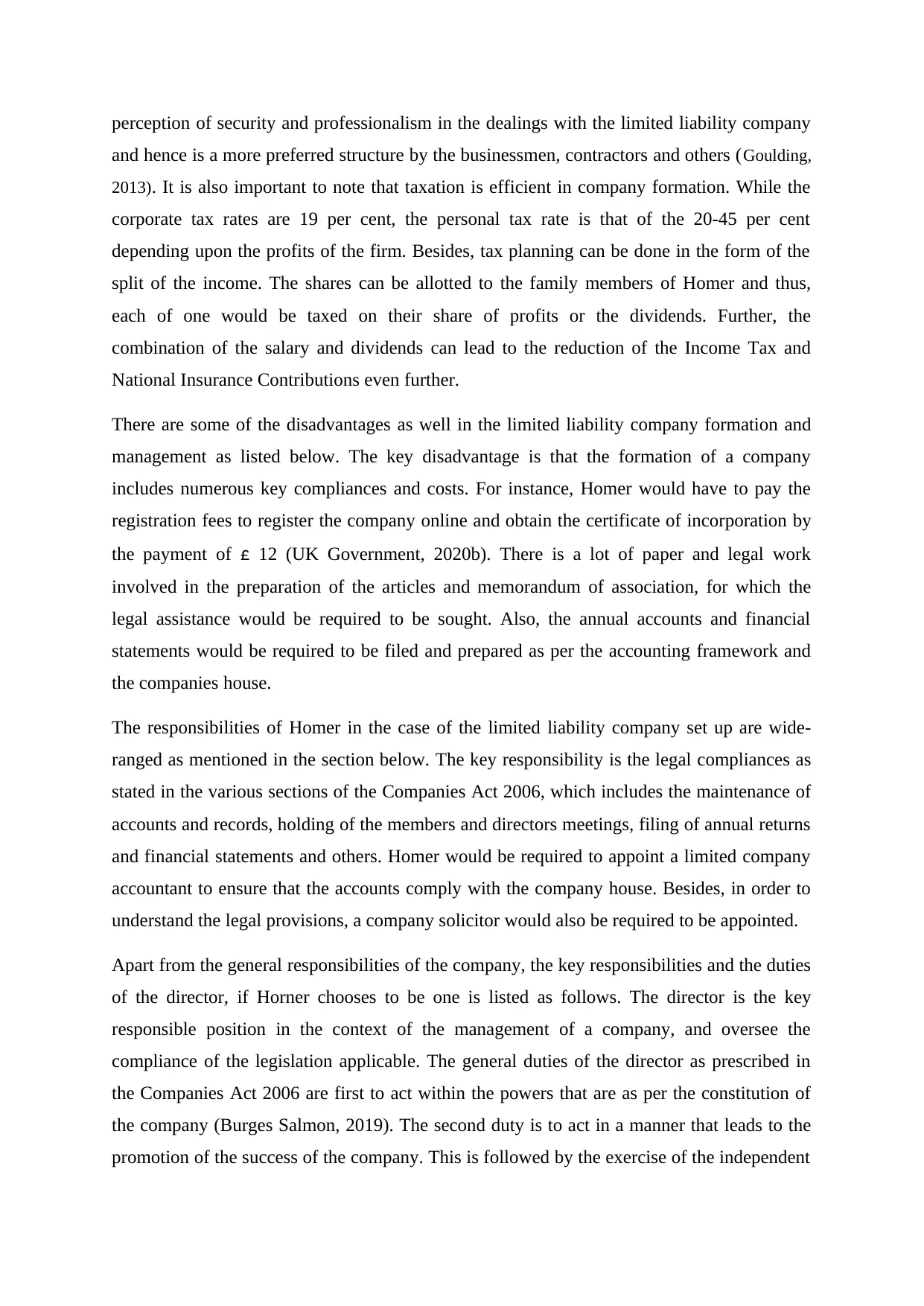
perception of security and professionalism in the dealings with the limited liability company
and hence is a more preferred structure by the businessmen, contractors and others (Goulding,
2013). It is also important to note that taxation is efficient in company formation. While the
corporate tax rates are 19 per cent, the personal tax rate is that of the 20-45 per cent
depending upon the profits of the firm. Besides, tax planning can be done in the form of the
split of the income. The shares can be allotted to the family members of Homer and thus,
each of one would be taxed on their share of profits or the dividends. Further, the
combination of the salary and dividends can lead to the reduction of the Income Tax and
National Insurance Contributions even further.
There are some of the disadvantages as well in the limited liability company formation and
management as listed below. The key disadvantage is that the formation of a company
includes numerous key compliances and costs. For instance, Homer would have to pay the
registration fees to register the company online and obtain the certificate of incorporation by
the payment of £ 12 (UK Government, 2020b). There is a lot of paper and legal work
involved in the preparation of the articles and memorandum of association, for which the
legal assistance would be required to be sought. Also, the annual accounts and financial
statements would be required to be filed and prepared as per the accounting framework and
the companies house.
The responsibilities of Homer in the case of the limited liability company set up are wide-
ranged as mentioned in the section below. The key responsibility is the legal compliances as
stated in the various sections of the Companies Act 2006, which includes the maintenance of
accounts and records, holding of the members and directors meetings, filing of annual returns
and financial statements and others. Homer would be required to appoint a limited company
accountant to ensure that the accounts comply with the company house. Besides, in order to
understand the legal provisions, a company solicitor would also be required to be appointed.
Apart from the general responsibilities of the company, the key responsibilities and the duties
of the director, if Horner chooses to be one is listed as follows. The director is the key
responsible position in the context of the management of a company, and oversee the
compliance of the legislation applicable. The general duties of the director as prescribed in
the Companies Act 2006 are first to act within the powers that are as per the constitution of
the company (Burges Salmon, 2019). The second duty is to act in a manner that leads to the
promotion of the success of the company. This is followed by the exercise of the independent
and hence is a more preferred structure by the businessmen, contractors and others (Goulding,
2013). It is also important to note that taxation is efficient in company formation. While the
corporate tax rates are 19 per cent, the personal tax rate is that of the 20-45 per cent
depending upon the profits of the firm. Besides, tax planning can be done in the form of the
split of the income. The shares can be allotted to the family members of Homer and thus,
each of one would be taxed on their share of profits or the dividends. Further, the
combination of the salary and dividends can lead to the reduction of the Income Tax and
National Insurance Contributions even further.
There are some of the disadvantages as well in the limited liability company formation and
management as listed below. The key disadvantage is that the formation of a company
includes numerous key compliances and costs. For instance, Homer would have to pay the
registration fees to register the company online and obtain the certificate of incorporation by
the payment of £ 12 (UK Government, 2020b). There is a lot of paper and legal work
involved in the preparation of the articles and memorandum of association, for which the
legal assistance would be required to be sought. Also, the annual accounts and financial
statements would be required to be filed and prepared as per the accounting framework and
the companies house.
The responsibilities of Homer in the case of the limited liability company set up are wide-
ranged as mentioned in the section below. The key responsibility is the legal compliances as
stated in the various sections of the Companies Act 2006, which includes the maintenance of
accounts and records, holding of the members and directors meetings, filing of annual returns
and financial statements and others. Homer would be required to appoint a limited company
accountant to ensure that the accounts comply with the company house. Besides, in order to
understand the legal provisions, a company solicitor would also be required to be appointed.
Apart from the general responsibilities of the company, the key responsibilities and the duties
of the director, if Horner chooses to be one is listed as follows. The director is the key
responsible position in the context of the management of a company, and oversee the
compliance of the legislation applicable. The general duties of the director as prescribed in
the Companies Act 2006 are first to act within the powers that are as per the constitution of
the company (Burges Salmon, 2019). The second duty is to act in a manner that leads to the
promotion of the success of the company. This is followed by the exercise of the independent
Paraphrase This Document
Need a fresh take? Get an instant paraphrase of this document with our AI Paraphraser
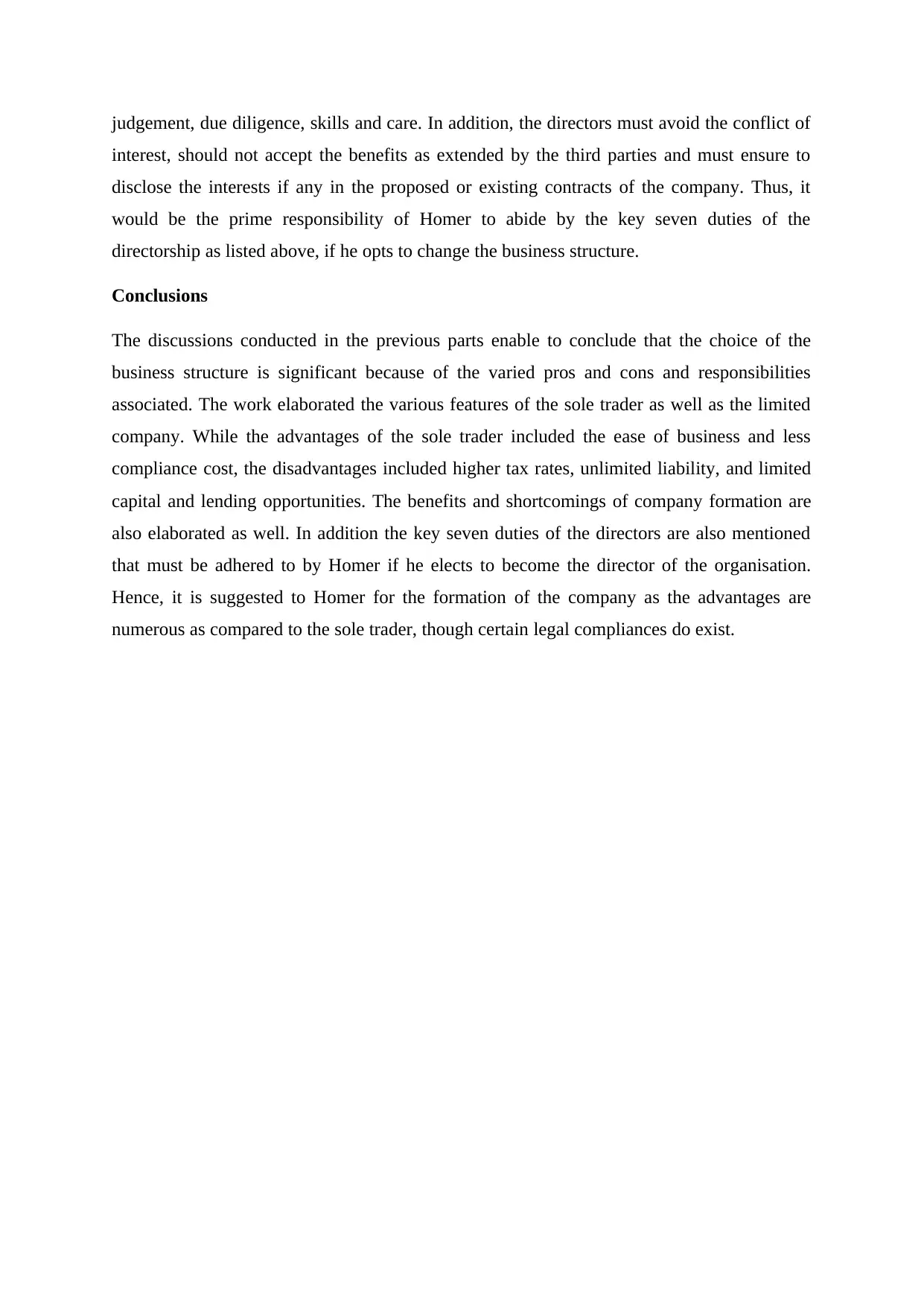
judgement, due diligence, skills and care. In addition, the directors must avoid the conflict of
interest, should not accept the benefits as extended by the third parties and must ensure to
disclose the interests if any in the proposed or existing contracts of the company. Thus, it
would be the prime responsibility of Homer to abide by the key seven duties of the
directorship as listed above, if he opts to change the business structure.
Conclusions
The discussions conducted in the previous parts enable to conclude that the choice of the
business structure is significant because of the varied pros and cons and responsibilities
associated. The work elaborated the various features of the sole trader as well as the limited
company. While the advantages of the sole trader included the ease of business and less
compliance cost, the disadvantages included higher tax rates, unlimited liability, and limited
capital and lending opportunities. The benefits and shortcomings of company formation are
also elaborated as well. In addition the key seven duties of the directors are also mentioned
that must be adhered to by Homer if he elects to become the director of the organisation.
Hence, it is suggested to Homer for the formation of the company as the advantages are
numerous as compared to the sole trader, though certain legal compliances do exist.
interest, should not accept the benefits as extended by the third parties and must ensure to
disclose the interests if any in the proposed or existing contracts of the company. Thus, it
would be the prime responsibility of Homer to abide by the key seven duties of the
directorship as listed above, if he opts to change the business structure.
Conclusions
The discussions conducted in the previous parts enable to conclude that the choice of the
business structure is significant because of the varied pros and cons and responsibilities
associated. The work elaborated the various features of the sole trader as well as the limited
company. While the advantages of the sole trader included the ease of business and less
compliance cost, the disadvantages included higher tax rates, unlimited liability, and limited
capital and lending opportunities. The benefits and shortcomings of company formation are
also elaborated as well. In addition the key seven duties of the directors are also mentioned
that must be adhered to by Homer if he elects to become the director of the organisation.
Hence, it is suggested to Homer for the formation of the company as the advantages are
numerous as compared to the sole trader, though certain legal compliances do exist.
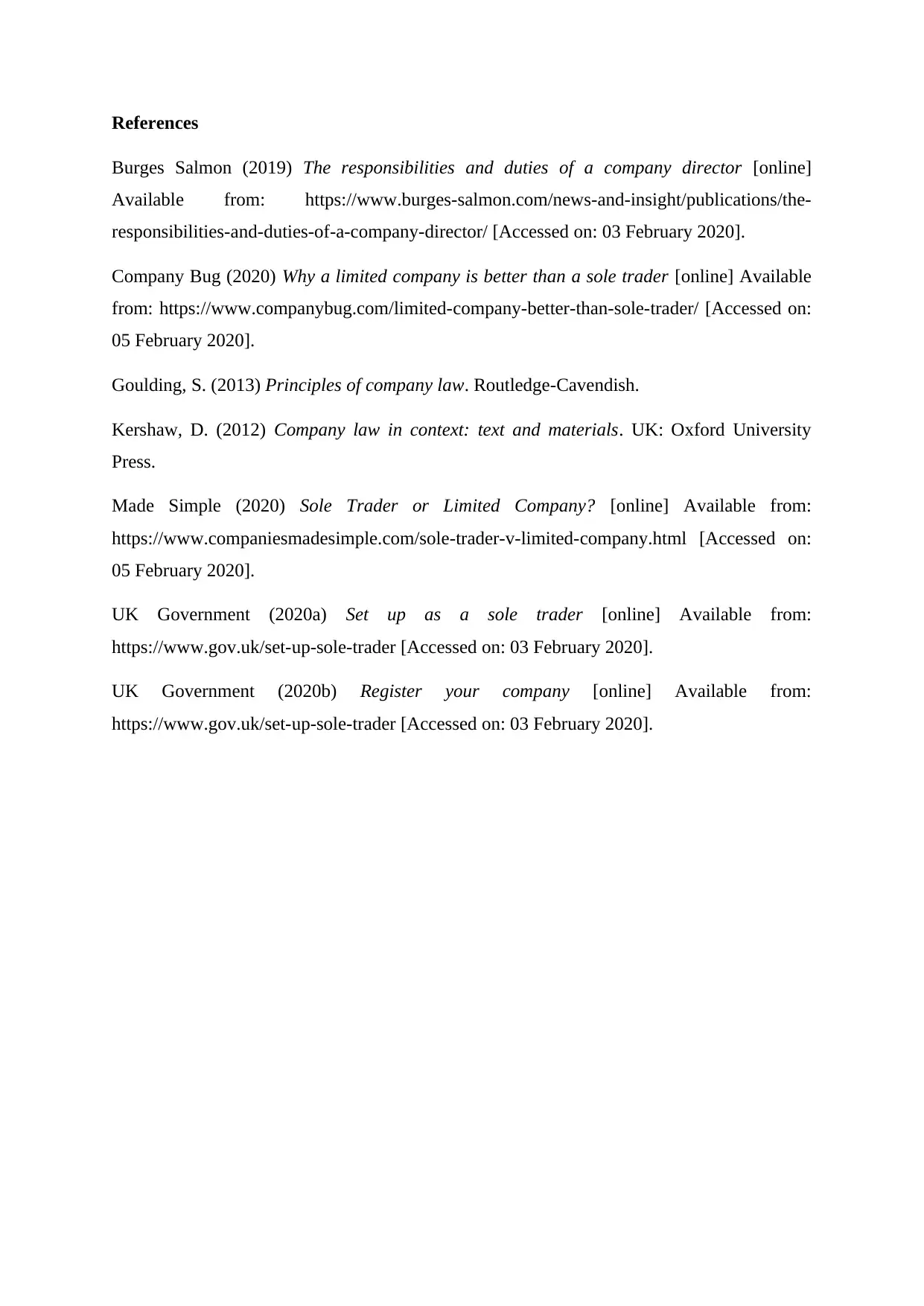
References
Burges Salmon (2019) The responsibilities and duties of a company director [online]
Available from: https://www.burges-salmon.com/news-and-insight/publications/the-
responsibilities-and-duties-of-a-company-director/ [Accessed on: 03 February 2020].
Company Bug (2020) Why a limited company is better than a sole trader [online] Available
from: https://www.companybug.com/limited-company-better-than-sole-trader/ [Accessed on:
05 February 2020].
Goulding, S. (2013) Principles of company law. Routledge-Cavendish.
Kershaw, D. (2012) Company law in context: text and materials. UK: Oxford University
Press.
Made Simple (2020) Sole Trader or Limited Company? [online] Available from:
https://www.companiesmadesimple.com/sole-trader-v-limited-company.html [Accessed on:
05 February 2020].
UK Government (2020a) Set up as a sole trader [online] Available from:
https://www.gov.uk/set-up-sole-trader [Accessed on: 03 February 2020].
UK Government (2020b) Register your company [online] Available from:
https://www.gov.uk/set-up-sole-trader [Accessed on: 03 February 2020].
Burges Salmon (2019) The responsibilities and duties of a company director [online]
Available from: https://www.burges-salmon.com/news-and-insight/publications/the-
responsibilities-and-duties-of-a-company-director/ [Accessed on: 03 February 2020].
Company Bug (2020) Why a limited company is better than a sole trader [online] Available
from: https://www.companybug.com/limited-company-better-than-sole-trader/ [Accessed on:
05 February 2020].
Goulding, S. (2013) Principles of company law. Routledge-Cavendish.
Kershaw, D. (2012) Company law in context: text and materials. UK: Oxford University
Press.
Made Simple (2020) Sole Trader or Limited Company? [online] Available from:
https://www.companiesmadesimple.com/sole-trader-v-limited-company.html [Accessed on:
05 February 2020].
UK Government (2020a) Set up as a sole trader [online] Available from:
https://www.gov.uk/set-up-sole-trader [Accessed on: 03 February 2020].
UK Government (2020b) Register your company [online] Available from:
https://www.gov.uk/set-up-sole-trader [Accessed on: 03 February 2020].
⊘ This is a preview!⊘
Do you want full access?
Subscribe today to unlock all pages.

Trusted by 1+ million students worldwide
1 out of 6
Related Documents
Your All-in-One AI-Powered Toolkit for Academic Success.
+13062052269
info@desklib.com
Available 24*7 on WhatsApp / Email
![[object Object]](/_next/static/media/star-bottom.7253800d.svg)
Unlock your academic potential
Copyright © 2020–2025 A2Z Services. All Rights Reserved. Developed and managed by ZUCOL.




